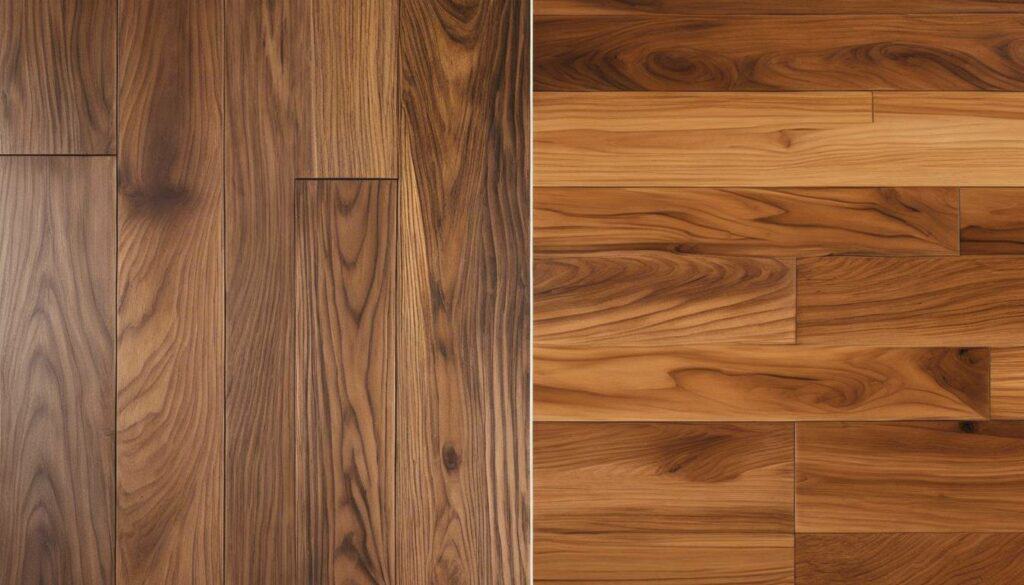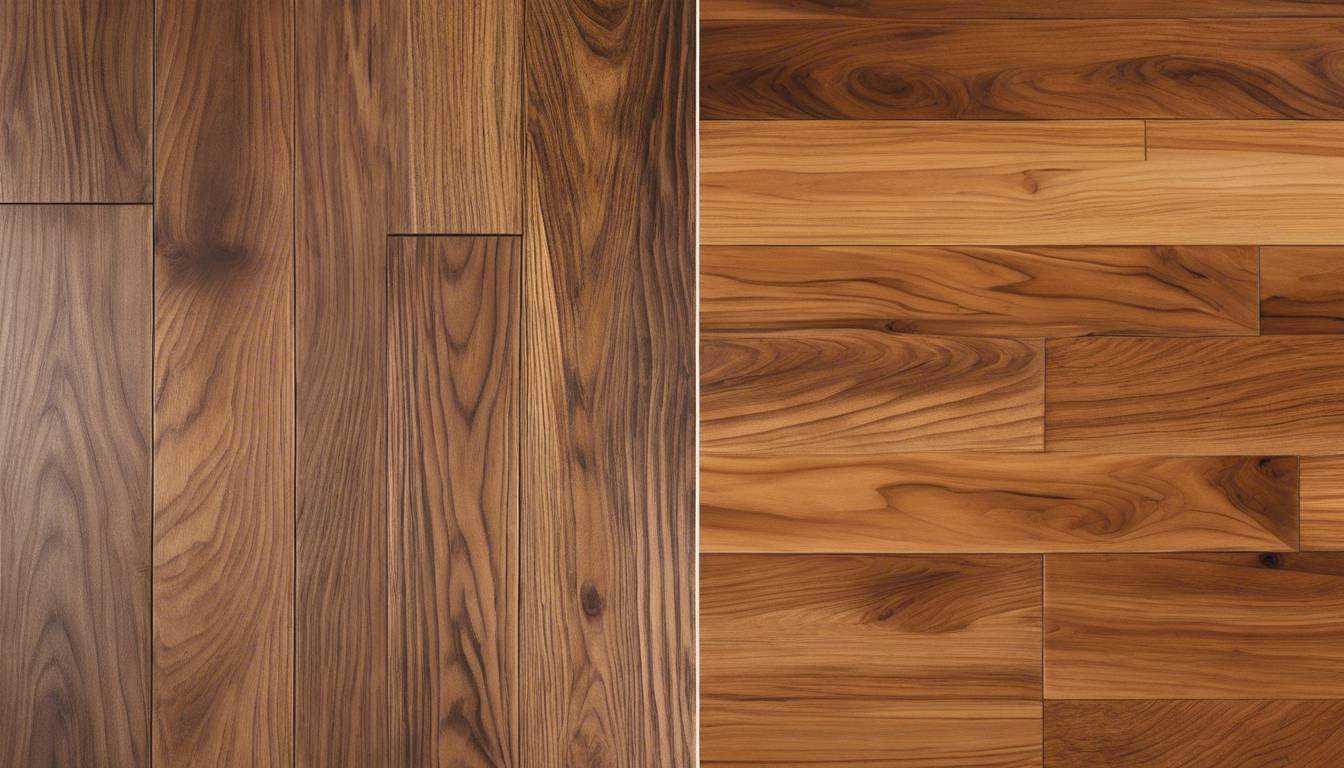I have been working with all types of floors for over a decade and I have strong opinions about it. While a side-by-side comparison of hardwood and laminate flooring reveals that each option offers its own set of unique benefits. Genuine hardwood floors can add a touch of luxury and increase property value, laminate flooring has made great strides in terms of both visual appeal and durability. However, before you make your decision, remember that things like cost, maintenance, and even the room’s use could tip the scale. Careful consideration of these factors will pave the path to your flooring selection.
Hardwood flooring is made of solid hardwood material throughout, offering a timeless, natural look and an extended lifespan with proper care. On the other hand, laminate flooring provides an affordable alternative that simulates the appearance of real wood, with greater water resistance and easier DIY installation. Both options have unique characteristics, so it’s important to consider factors such as budget, maintenance, and desired aesthetics when making a decision.
Hardwood versus Laminate: An Overview
Choosing the right flooring for your home is a significant decision with long-term impact. When comparing hardwood and laminate flooring, it’s crucial to consider various factors such as durability, maintenance, cost, and overall appearance. Let’s start by understanding the fundamental differences between these two popular flooring options.
Material and Construction
Hardwood flooring is made of solid wood throughout its thickness, offering unmatched authenticity and natural variation. On the other hand, laminate flooring consists of a core layer of fiberboard with a realistic image of wood printed on top and a protective wear layer. The construction of these two materials is distinct, with solid hardwood emanating from nature and laminate designed to replicate the look of hardwood through engineered construction.
While there’s no mistaking the beauty and warmth of real wood, modern laminate manufacturers have achieved impressive results in mimicking the visual appeal of hardwood. From rich oak tones to classic maple finishes, laminate flooring is available in a wide range of designs and textures, providing homeowners with diverse options to suit their aesthetic preferences. This makes it an attractive alternative for those seeking cost-effective solutions without compromising on style.
Durability and Maintenance
Hardwood floors, renowned for their durability and longevity, can be sanded down and refinished multiple times, rejuvenating their appearance over several decades. Regular care involves sweeping or vacuuming to remove dust and debris, followed by damp mopping with a suitable wood cleaner. For more detailed instructions, check out our guide on the best way to clean wood floors. Laminate flooring, however, features a tough external layer that wards off scratches, impacts, and staining from common household spills. Cleaning laminate floors is relatively effortless—a quick vacuum or broom coupled with occasional mopping using a damp cloth effectively maintains its pristine condition.
It’s important to note that while both options offer unique benefits in terms of maintenance, laminates bear an advantage in high-traffic areas or homes with pets due to their resistance to scratches. Conversely, solid hardwood floors necessitate more cautious consideration when it comes to potentially damaging factors like moisture and heavy wear. When comparing different types of hardwood, such as hickory vs maple flooring, these factors become even more crucial.
Having explored some primary distinctions between hardwood and laminate flooring, it’s becoming evident how each option caters to different needs and preferences. Let’s further delve into this comprehensive comparison to help you make an informed choice based on your specific requirements.
Aesthetic Appeal of Hardwood and Laminate Flooring
When it comes to the aesthetic appeal of flooring, it’s not just about looks—it’s about creating an atmosphere. Let’s start with hardwood flooring. It’s like a timeless piece of art that never goes out of style. The beauty of hardwood flooring lies in its ability to exude a natural warmth and authenticity that can transform any space into something truly remarkable. Each plank carries a unique grain and texture, giving it character and charm that elevates the entire room.
Now, imagine the coziness of a mountain cabin or the elegant feel of a historic estate – these sensations are often embodied by the look and feel of hardwood. Its natural variations create an inviting ambiance that just can’t be replicated. This organic quality gives every hardwood floor a one-of-a-kind touch.
On the other hand, laminate flooring is designed to give you the same visual effect as hardwood, without the same price tag. It offers a wide array of patterns and colors, providing homeowners with incredible versatility in design options.
While some may argue that laminate lacks the authentic look and feel of real wood, modern technology has made remarkable advancements in producing laminate flooring that closely resembles genuine hardwood. This innovation allows homeowners to achieve the look they desire without sacrificing their budget or ethical concerns about deforestation.
But there is a difference in quality when it comes to laminate. Some low-quality laminates have boards that repeat patterns, resulting in a somewhat less realistic wood look. This repetition can affect its overall visual appeal. Imagine staring at your floor and seeing the same pattern repeated over and over—that repetition can take away from the illusion it tries to create.
It’s like watching a movie where you can predict every line before it’s spoken – the magic just isn’t there anymore.
So, while laminate offers incredible design flexibility, there are areas where its visual appeal might fall short compared to the natural allure of authentic hardwood.
In summary, both hardwood and laminate have their unique appeals in terms of aesthetics. The former boasts a timeless elegance and unmatched natural warmth, while the latter provides versatility and affordability in design but may lack the genuine appeal found in real wood products. It ultimately comes down to personal preferences, budget considerations, and desired aesthetic outcomes for your living space.
In navigating the world of flooring, aesthetics are just one piece of the puzzle. Now, let’s shift our focus to another crucial aspect—durability—in evaluating Hardwood vs Laminate Flooring.
Durability: Hardwood vs Laminate
When it comes to durability, solid hardwood floors are well-regarded for their outstanding longevity. With proper care and maintenance, they can endure for a lifetime and even longer. The secret to their resilience lies in the fact that they are made entirely of solid hardwood material throughout. Furthermore, solid hardwood flooring has the unique advantage of being refinished multiple times, which breathes new life into the floor by refreshing its appearance.
Refinishing a solid hardwood floor involves sanding down the top layer to remove any scratches or wear and then applying a new stain and finish. This process can be repeated several times over the lifespan of the floor, making it an extremely durable and long-lasting flooring option. The ability to sand and refinish solid wood floors gives them a significant edge in terms of durability compared to laminate flooring.
Laminate Flooring
Conversely, laminate floors offer a different form of durability. While they boast an average lifespan of 15 to 25 years, they may lack the longevity of solid hardwood floors. However, laminate flooring holds its own in terms of resistance to moisture and is particularly suitable for high-traffic areas due to its wear-resistant nature. This makes it an ideal choice for homes with children or pets, where spills and heavy foot traffic are common occurrences.
Despite being more moisture-resistant than solid hardwood, it’s important to note that neither laminate nor solid hardwood is recommended for wet areas such as bathrooms or laundry rooms. However, laminate flooring generally fares better than solid hardwood when exposed to moisture.
Imagine a busy household with children and pets – laminate flooring offers a practical solution by providing durability and water resistance without sacrificing aesthetic appeal. This makes it easier to maintain and keeps its attractive appearance intact for an extended period.
Turning our attention away from durability, let’s move on to examining the maintenance requirements of both hardwood and laminate flooring.
Hardwood and Laminate Installation: A Comparison
When considering installation, notable differences emerge between solid hardwood and laminate flooring. The installation process for solid hardwood flooring can be quite complex, involving the precise nailing down of boards to ensure a seamless finish.
Installing solid hardwood floors is best left to professionals or individuals with significant experience in flooring installation. This is especially true when you need to transition between two different wood floors, which requires additional expertise. This process requires meticulous attention to detail, specialized tools, and an understanding of woodwork. Proper layout and secure fixing are vital to prevent issues with warping or movement over time. Professional installers ensure that each plank of solid hardwood is meticulously installed, contributing to its longevity and overall appeal.
Solid Hardwood Flooring Installation
| Key Points |
|---|
| – Requires nailing down the boards |
| – Best executed by professionals or experienced individuals |
| – Demands precision and attention to detail for a lasting finish |
On the other hand, laminate flooring offers a contrasting installation experience. Its innovative design as a floating floor eliminates the need for nails or glue during installation. This feature makes laminate flooring especially appealing to DIY enthusiasts looking to take on home improvement projects themselves.
Laminate Flooring Installation
| Key Points |
|---|
| – Floating floor that requires no nailing or glue |
| – Attracts DIY enthusiasts due to its approachable installation process |
| – Ideal for those looking to undertake self-installation projects |
The decision between installing solid hardwood or laminate flooring depends on factors such as individual skill level, time constraints, and desired outcome. While solid hardwood demands a higher degree of expertise, laminate offers a more approachable option suitable for those considering a DIY installation project.
Understanding these differences in installation methods sheds light on the various aspects homeowners should consider when selecting between hardwood and laminate flooring options.
Cost Implications: Hardwood and Laminate
When it comes to flooring options, cost plays a significant role in decision-making. Hardwood flooring is without a doubt an investment, ranging from $4 to $8 per square foot for common hardwoods. While it may seem like a substantial upfront investment, the longevity and timeless appeal of hardwood floors can justify the cost for many homeowners. Hardwood flooring isn’t just about the immediate impact on your wallet; it’s an investment in the long-term value and character of your home.
Expanding on this idea, unlike laminate, hardwood floors are known for their exceptional durability. They are designed to last for decades with proper care, offering a beautiful and timeless aesthetic that enhances the overall value of your property. Whether you’re planning to sell your home in the future or simply want to create a warm and inviting space, hardwood flooring can significantly enhance the appeal of any room.
Just as an antique piece of furniture holds its value over time, hardwood floors can withstand wear and tear while maintaining their charm. Homeowners often find that the lasting beauty and durability of hardwood flooring outweighs the upfront investment.
The Consideration of Laminate Flooring
Conversely, laminate flooring typically costs $1 to $3 per square foot, making it a more budget-friendly option upfront. The lower initial cost might be appealing, especially for those working within a strict budget.
On the other hand, when considering the long-term implications beyond just the initial purchase price, it’s essential to weigh the overall value of laminate flooring. While it may offer immediate savings, laminate tends to have a shorter lifespan compared to hardwood. This means that homeowners may need to replace laminate flooring more frequently than they would with hardwood, which could result in additional costs over time.
Taking into account these aspects related to cost implications, homeowners must carefully evaluate their budgetary constraints, long-term goals for their property, and personal preferences when choosing between hardwood and laminate flooring options.
In understanding these financial considerations associated with different flooring options, homeowners can now make informed decisions ensuring that they align with their budget and long-term aspirations for their property.
Choosing Your Flooring: Making the Hardwood or Laminate Decision
Deciding between hardwood and laminate flooring is a significant choice that requires thoughtful consideration. To make an informed decision, you should weigh several essential factors. Let’s explore these key aspects in detail, providing you with valuable insights to guide your flooring selection journey.
Budget
One of the primary considerations when choosing between hardwood and laminate flooring is your budget. Hardwood flooring is often seen as a high-end option due to its natural beauty and durability, but it comes with a higher price tag compared to laminate flooring. On the other hand, laminate flooring offers a more cost-effective alternative that can mimic the look of hardwood at a fraction of the cost. Consider your budget constraints and long-term financial goals when making this decision.
Lifestyle and Demands
The demands of your lifestyle and the specific requirements of the space where the flooring will be installed play a vital role in determining the most suitable option for you. If you have a busy household with children and pets, durability and resistance to wear and tear are crucial factors to ponder. Both hardwood and laminate have their distinct characteristics in terms of resilience, maintenance requirements, and resistance to moisture. Take into account your everyday activities, traffic flow in the room, and any potential environmental factors that could impact your flooring choice.
Design Preferences
Your design preferences and aesthetic vision for the space are paramount in guiding your decision. Hardwood flooring exudes timeless elegance, natural warmth, and distinctive character that can enhance the overall ambiance of your home. On the other hand, laminate flooring offers a wide array of design options, including realistic wood grain patterns, stone textures, and various colors to complement diverse interior styles. Understanding your personal style and design aspirations will help align your flooring choice with the desired visual appeal.
Expert Opinions and Real-Life Experiences
Seeking expert opinions from reputable sources and learning from real-life experiences can provide invaluable insights into the performance, maintenance, longevity, and overall satisfaction associated with both hardwood and laminate flooring. Online resources such as comprehensive guides on home improvement websites or forums can offer a wealth of knowledge based on shared experiences and professional advice.
By meticulously evaluating these fundamental factors—budget considerations, lifestyle demands, design preferences, and expert insights—you can navigate the decision-making process with clarity and confidence. Whether you prioritize the organic allure of hardwood or place emphasis on practicality and versatility through laminate options, understanding these critical elements will empower you to select the ideal flooring solution for your unique needs. For further detailed insights into hardwood and laminate flooring options, visit AmazingHomeDecorco for a complete guide on navigating this pivotal decision.
Detailed consideration of budgetary constraints, lifestyle demands, design preferences, and expert insights forms the foundation for an informed decision in selecting between hardwood and laminate flooring options. These crucial elements provide guidance in making this pivotal choice for your living space.






